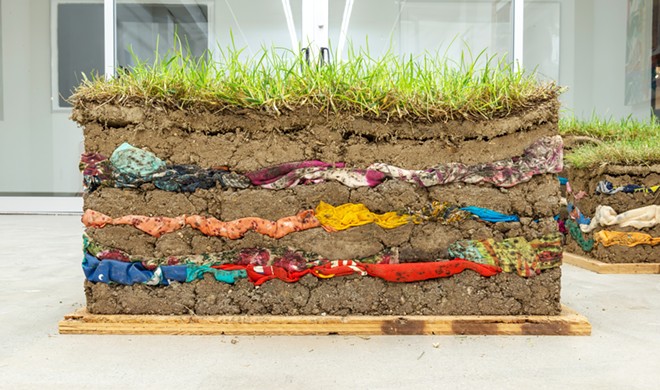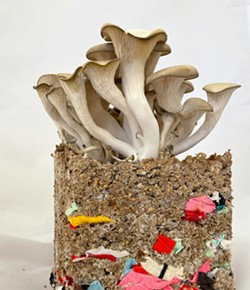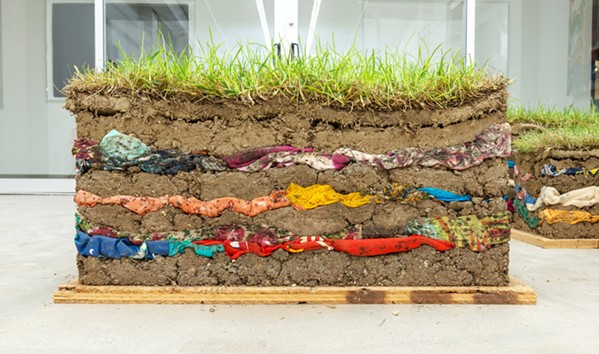SLOMA’s new mixed-media exhibit, Dirty Laundry, comments on fast fashion’s fallout – New Times SLO

For artist Minga Opazo, sometimes the best way to showcase both the problem and solution to an ever-growing issue is to weave the two together.
She combines research on the decomposing power of mushrooms with woven basket-like sculptures to illuminate the power of using science and art to find sustainable solutions that mitigate the fast fashion industry’s impact.
“The art is part of my research,” she said. “If I can contribute to people knowing about this issue through my work, then maybe we can continue to research ways [to solve the issue].”
Opazo’s work will be the center of the San Luis Obispo Museum of Art’s latest exhibition, where her pieces—some of which include real mushrooms—and those from several other California-based artists are on display from Dec. 2 through Feb. 27 as part of Dirty Laundry. Aiming to explore the consequences of, and provide sustainable alternatives to, the fast fashion industry and modern-day clothing production, the exhibit delves into the problems through a variety of media.
- Photo Courtesy Of Minga Opazo
- BURIED IN SAND Based on her experiences, artist Minga Opazo’s work highlights the strange plastic-infused landscape that permeates Chilean deserts.
Fast fashion is mass-produced cheap clothing. The manufacturing model relies on a quick turnaround for every aspect of the clothing business, including designing, fabricating, and selling the clothes, much of which is discarded. The average American throws away 70 pounds of clothes per year.
“The exhibition looks at the way [that] on the surface fast fashion may seem contained [but] it has implications that are in fact far-reaching,” according to SLOMA press materials.
Initially, Opazo’s research involved raw textiles often found in the area where she’s from around the Chilean desert, noting that they were easily decomposable and part of the cultural history. As her research and art continued to evolve, however, she saw things change.
“I began to notice that the [waste] textile was being shipped to countries like Chile and Africa as a ‘gift,'” she said. “A lot of the textile history we have in Chile is in the same spot that the textile waste ends up at.”
Historically mummies buried in the Chilean desert were wrapped in decomposable materials, allowing the bodies and material to naturally become part of the soil. The dry Pacific Ocean air combined with the already dry deserts allowed for the preservation of these textiles and by extension, Opazo said, the mummies. But with the rising use of plastic-based materials to make clothing, the air’s qualities started preserving all of those “gifts” that ended up in the desert.
- Photo Courtesy Of SLO Museum Of Art
- LAY IT ALL OUT Minga Opazo’s soil and textile-layered grass block will be a special on-site installation in the middle of the gallery as part of the Dirty Laundry exhibit.
Opazo’s contributions to Dirty Laundry include an on-site installation that tells the history of the world’s landscape and the relationship textiles have with it. That show centerpiece is directly inspired by her study of soil samples in Chilean deserts, where volcanic activity has molded plastic into every layer of the soil.
“The new archeology is going to be all of this plastic we don’t really take care of,” Opazo said. “It is embedded into fossils here and is part of them now.”
Her installation features layers of clothing enmeshed with dirt that enables viewers to see how deep the problem goes. Above all of those layers is a grass lawn, something Opazo said she really wanted to focus on.
“There isn’t anything more common than the lawn in America,” she said. “I wanted to use that to show off how the problem is right below the ground we walk on.”
Artist Alicia Pillar designed on-site installation pieces commenting on the immediacy of these issues. The structure of her art is made from reused textiles and evokes human cells, which Pillar said is meant to get viewers to think about fast fashion’s impact at the molecular level.
- Photo Courtesy Of SLO Museum Of Art
- THE SMALL THINGS Artist Sommer Roman’s work showcases the buildup of plastic textiles, portraying the impact of fast fashion at the microscopic level.
In the same spirit, San Luis Obispo-based artist Sommer Roman’s pieces are biomorphic sculptures made from post-consumer textiles intending to explore the role both humans and textiles play in the world together.
Photographer Aditi Mayer contributed photography-based galleries to the exhibit with a specific focus on the social repercussions of the industry. Mayer’s work highlights the plight of garment workers in Los Angeles and India, touching on protests held in both areas as well as exploring some potential solutions to the issues.
The goal of the exhibit, according to SLOMA, is to leave visitors with as powerful an impact as the one that textiles have on the environment.
“Visitors will be invited to turn an eye to their own practices, and to think about the ways in which we can all contribute to a healthier and more sustainable world,” museum officials said in a statement.
“The exhibition brings together artists who are both deeply engaged with this industry, and committed to proposing solutions through their practice.”
Opazo hopes that Dirty Laundry can help people from around the world understand that it’s not too late to fix the issues caused by fast fashion.
“By introducing the mushrooms and other decomposers to the waste, my idea is to show that if we put our brains together and combine science and art and [whatever] else may come along in the future, we can have hope,” she said. Δ
Contributor Adrian Vincent Rosas is reflecting on sustainable holiday gifts. Reach him through the editor at clanham@newtimesslo.com.
Copyright :




